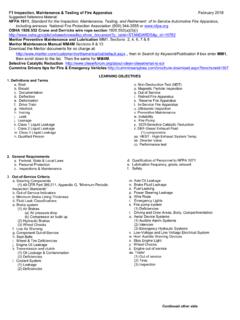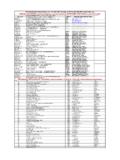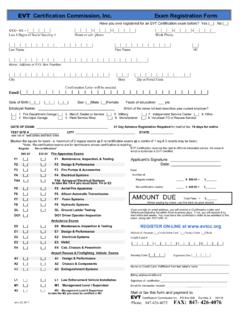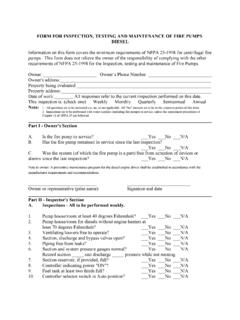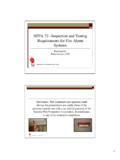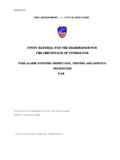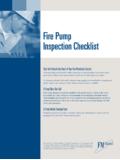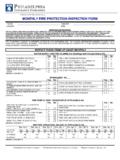Transcription of E-4 Ambulance Cab, Chassis and Powertrain June …
1 E-4 Ambulance Cab, Chassis and Powertrain June 2018. Reference Materials: Note: This exam may contain some "accepted practice" type questions not found in the reference material listed below. NFPA 1917, Standard for Automotive Ambulances, including annexes NFPA 1911, Standard for the Inspection, Maintenance, Testing, and Retirement of In-Service Automotive Fire Apparatus National Fire Protection Association, Quincy, MA. To order call (800) 344-3555 or Ford Ambulance QVM Guide, General shop manuals, such as: Ford 1-ton Chassis , Freightliner Medium Duty, International/Navistar Medium Duty, Allison Transmission E books Any service manual for OBD-2, Class 1 Diagnostic Service Codes LEARNING OBJECTIVES FOR THE E-4 EXAM.
2 1. Physical Characteristics of an Ambulance - Identify the design requirements as stated in NFPA 1917: a. Height, width, wheel base & length d. Weight distribution b. Ambulance types e. Rearview mirrors c. Ambulance class & configurations 2. Cab and Body - Identify components and location. Describe maintenance and repair of the following: a. Doors, latches & hardware e. Warning light system b. Oxygen Systems (1) Do not move light (1) Maximum leakage (2) Low voltage (2) Hose requirements f. Patient compartment c. Dissimilar metals (1) seat belts warning signal d. Handrails g. Back up alarm (1) Control (2) Decibels 3.
3 Chassis - Describe principles fo operation, maintenance, and repair of the following: a. Brakes b. Suspension (1) Hydraulic brake systems & fluid types (1) Tires & wheels (a) Fluid level (a) Tire balance (2) Parking brakes and cables (b) Tire size (3) Anti-lock systems (c) Tire air pressure/monitoring system (a) Wiring (2) Wheel nuts/torque (b) Bleeding (3) Air ride height adjustment (c) Driveline retarder c. Frame (4) Brake assemblies (1) Body & cab mounts (a) Rotors d. Steering (b) Rotor measurements (i) Symptoms (c) Rotor run out (2) Alignment (5) Brake retarder installation 4.
4 Powertrain - describe principles of operation, maintenance and repair of the following a. Power train control module (7) Fluid b. Engine (a) Purpose (1) Breakout box use (b) Level (2) Effects of water in fuel (c) Types (3) Coolant additives (d) Change intervals (4) Common rail diesel fuel systems (e) Effects of coolant contamination (5) Diesel exhaust service (8) Electronic controls (a) After treatment (a) Shift point after calibration c. Automatic transmissions (b) Main ECU power and ground wiring (1) Torque convertor (c) Cleaning connectors (a) Components (d) Effects of electromagnetic interference (b) Function (EMI).
5 (c) Installation (e) Effects of radio transmitter interference (2) Towing vehicle with automatic transmission d. Drive line (3) Manual downshifting (1) Inspection (4) Rocking vehicle with automatic transmission (2) Driveline angle (5) Inspection (3) Driveline phasing (a) Gauges and indicators (4) Slip joints & U-joints (b) Exterior (5) Vibration causes (c) Diagnostic codes (6) RPM test (6) Maintenance e. Differentials (a) Service intervals (1) Vibration (b) Required procedures after overhaul or f. Road speed test replacement (c) Fluid change 5. Troubleshooting & Diagnostics -Understand accepted practices of the following: a.
6 Retrieving and interpreting diagnos tic codes g. Welding precautions (1) Breakout box h. Driveline b. Interpret diagnostic charts and service manuals (1) Vibration (1) Idle Validation Switch wiring (2) Driveline test c. Understanding schematic drawings i. Engine d. Using diagnostic equipment (1) Leaks diagnoses (1) Multi-meter uses (2) Slow cranking e. Road testing for driveability problems (3) Glow plug diagnostics f. Transmission (4) Effects of clogged air filter (1) Fluid (5) Cause of pressure buildup in radiator (a) Levels (6) Effect of incorrect muffler installation (b) Contamination j.
7 Differential (c) Effects of coolant contamination (1) Chattering noise (d) Fluid level too high k. Troubleshooting steps (e) Metal contaminated fluid l. Brakes (2) Effects of a clogged breather (1) ABS braking systems (3) Adjustments (2) Brake testing (a) Linkage (3) Boosters (b) Shift points (4). (5) Electronic controls (a) Multiple fault code (b) Troubleshooting steps (c) Cause of not shifting into gear (d) Effect of poor battery connections (e) Effects of water in connectors (f) Historical code use (6) Output shaft seal and yoke (7) Stall test (8) Troubleshooting procedure (a) basic (b) no code troubleshooting (9) Leak diagnoses (10) causes of overheating 6.
8 Safety - Identify and describe the following: a. Safety procedures (1) Use of wheel chocks (2) Proper lifting & support equipment (3) Right to know law b. Out of Service criteria (1) Hydraulic brakes (2) Engine oil leaks (3) Automatic transmission (4) Identifying out of service vehicle or component (5) body mounts (6) windshield wipers c. Equipment Storage and Mounting
